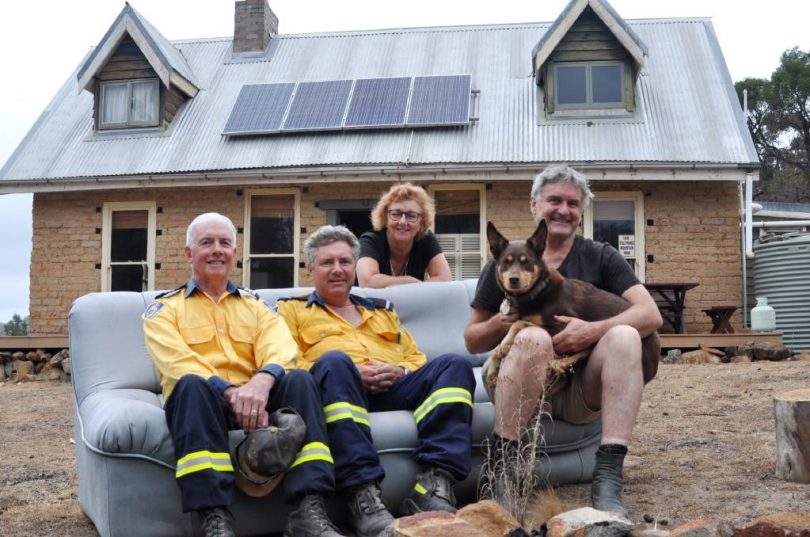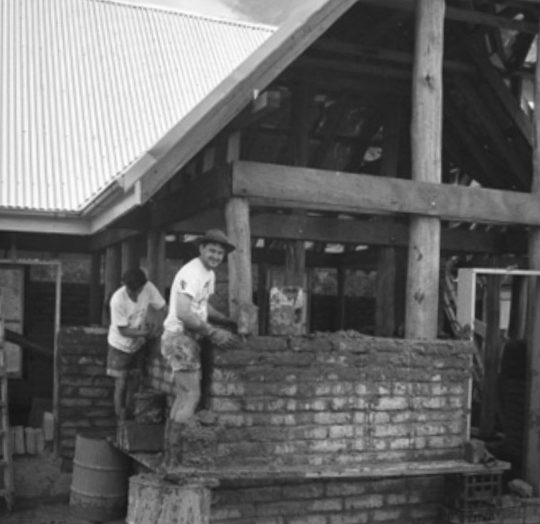
ABC journalist Richard Glover (right) and screenwriter Debra Oswald pictured in front of their mud-brick house with Taralga Rural Fire Brigade Captain John Sullivan (left) and member Peter Davies after the 2019 Green Wattle Creek Fire. Photo: Hannah Sparks.
At the end of a maddening week, as husband and wife, Richard Glover and Debra Oswald, shake off the three-hour drive from Sydney, they pause for a moment and marvel at the fact their Wombeyan Caves weekender is still standing.
The slightly sloping, very rocky bush block was purchased by the well-known ABC Radio presenter, the creator of the television show Offspring, their friend Philip Clark and his then-girlfriend, Gillian, for $27,000 in 1984.
It was what you would call the best of a bad bunch, and looked even better after consuming a bladder of cheap port – a reminder that you were broke.
This would be their first home, built out of blissful ignorance and a back-breaking 3500 mud bricks.
The two couples had met in their early 20s at the Australian National University (ANU) in Canberra. As their romances blossomed and graduation passed by, Richard and Debra moved to Sydney, while Philip and Gillian stayed in Canberra.

Richard Glover and Debra Oswald camp out at their new bush block in the 1980s. Photo: Supplied.
Wombeyan Caves was almost halfway between Sydney and Canberra and, perhaps more importantly, the land there was cheap.
“I still remember the first time we went there and going in on the state’s worst road, to Wombeyan Caves,” says Richard with a chuckle.
“We saw one block of land that was incredibly huge and incredibly cheap, maybe 1000 acres, but it only cost $30,000. We asked what the land was like and he had to be the world’s only honest real estate agent because he said ‘vertical’!
“Then we went a bit further and found this other little block and bought it for about $27,000, which used up all our money and credit cards.
“That’s where the mud-brick idea came from because we wanted to get stuck in but didn’t have any money for building materials.”
To make a mud brick, all you need is a whole lot of dirt, a sieve to separate the rocks from the dirt, water, a spadeful of cement, a handful of straw to bind the brick together, a pit to mix the ingredients in, and a mould.
The couples got to work straight away, dedicating almost every weekend to sleeping in tents while digging trenches, levelling the ground, felling trees for poles and, of course, making many a mud brick – all without a single power tool.

Richard Glover and Philip Clark begin the back-breaking process of making mud bricks. Photo: Supplied.
The corners of the house were mapped out using what they could remember of Pythagoras theorem from school. Rafters were hauled by cars, and mud pits were churned with 20-something-year-old bodies. It was a buoyant time in which everything felt possible.
“There are photos of us camping at the block at the very end of 1984 when we decided we were going to buy it,” says Debra.
“It’s funny to think there was this one window of time when we had just enough money to buy it between the four of us, but not enough money to buy houses, and we weren’t tied up with mortgages and children, and all those sensible things that would stop you from doing it.
“You have these crazy ideas late at night with a lot of red wine onboard, but just at the right time we jumped in.”
The mud-brick house was a labour of love for 20 or so years, and grew as their careers and families did. Richard and Debra’s youngest child, Daniel, became the fifth person on the construction site in 1987.
Not long after, Richard was offered an opportunity to leave a Sydney newspaper and work as a European correspondent in London. The family accepted the opportunity, but couldn’t shake the bush block from their bones.
After 14 months, they were homesick.

Richard Glover and Philip Clark build the house walls with mud bricks. Photo: Supplied.
The mud bricks went on to inspire one of Debra’s greatest plays, Gary’s House, about a group of no-hopers building a house in the bush.
Joe, the couple’s eldest child, had missed out on the early construction of the house but was keen to make his mark at age 14. With the help of dad, Philip and a friend, he set about making more mud bricks for the extension, affectionately and appropriately known as The Delphi Bar, after a family trip to Greece.
Today, the mud brick house still stands despite the Green Wattle Creek bushfire that crept up to the block’s fringes in 2019 and destroyed a shed and caravan, and blew the top off the septic tank.
The fire reinforced the house’s place in their lives as a refuge from the world, a place to go off-grid and reconnect.
“There’s a real sense that this land is still raw and wild, and human beings are just a very recent arrival,” says Debra. “I think that’s good for the soul.”
You can read the full story and many more hilarious anecdotes in Richard’s book, The Mud House: How Four Friends Built a Place in the Bush.







